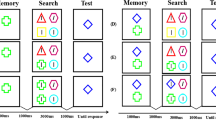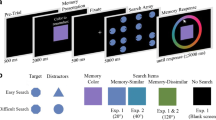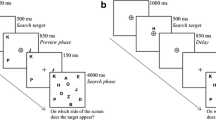Abstract
Previous studies have only focused on the interference effect induced by multiple task-irrelevant representations from the same dimensions in visual working memory (VWM). The present study reexamined the issue by not only focusing on interference effect but also facilitation effect induced by multiple task-irrelevant representations from the same dimension in VWM. Furthermore, the guidance effect of multiple task-irrelevant representations from different dimensions in VWM was also investigated. Participants were instructed to complete a gap-location search task while holding two items in VWM. In Experiment 1, one of the colors (match-1) or both colors in VWM (match-2) matched with one or two targets or distractors in the search array. No guidance effects were found for match-1 trials, but there was a reliable interference effect when both colors in VWM were presented as distractors and a facilitation effect when they matched the color of two search targets. Experiment 2 was carried out to examine the guidance effect produced by multiple task-irrelevant representations from different dimensions in VWM. Participants were required to memorize the color and direction of an arrow. Attentional guidance effects were found when each one of the VWM features matched the search target, but there was no additive facilitation effect when both features were validated in visual search. These results provide evidence that multiple items in VWM can guide the attention simultaneously, but the guidance effects are flexible and various across different types of stimuli.




Similar content being viewed by others
References
Anderson, E. J., Mannan, S. K., Rees, G., Sumner, P., & Kennard, C. (2010). Overlapping functional anatomy for working memory and visual search. Experimental Brain Research, 200(1), 91–107.
Awh, E., & Jonides, J. (2001). Overlapping mechanisms of attention and spatial working memory. Trends in Cognitive Sciences, 5(3), 119–126.
Bays, P. M., & Husain, M. (2008). Dynamic shifts of limited working memory resources in human vision. Science, 321(5890), 851–854.
Bays, P. M., Wu, E. Y., & Husain, M. (2011). Storage and binding of object features in visual working memory. Neuropsychologia, 49(6), 1622–1631.
Beck, V. M., & Hollingworth, A. (2017). Competition in saccade target selection reveals attentional guidance by simultaneously active working memory representations. Journal of Experimental Psychology. Human Perception and Performance, 43(2), 225–230.
Beck, V. M., & Luck, S. (2010). Guidance of attention during visual search: Can multiple attentional templates operate concurrently? Journal of Vision, 10(7), 1291–1291.
Beck, V. M., Hollingworth, A., & Luck, S. J. (2012). Simultaneous control of attention by multiple working memory representations. Psychological Science, 23(8), 887–898.
Britten, K. H., & Heuer, H. W. (1999). Spatial summation in the receptive fields of MT neurons. Journal of Neuroscience: The Official Journal of the Society for Neuroscience, 19(12), 5074–5084.
Carlisle, N. B., & Woodman, G. F. (2011). Automatic and strategic effects in the guidance of attention by working memory representations. Acta Psychologica, 137(2), 217–225.
Chen, Z., & Tsou, B. H. (2011). Task-based working memory guidance of visual attention. Attention, Perception & Psychophysics, 73(4), 1082–1095.
Chun, M. M., & Johnson, M. K. (2011). Memory: Enduring traces of perceptual and reflective attention. Neuron, 72(4), 520–535.
Courtney, S. M., Ungerleider, L. G., Keil, K., & Haxby, J. V. (1996). Object and spatial visual working memory activate separate neural Systems in Human Cortex. Cerebral Cortex, 6(1), 39–49.
Desimone, R., & Duncan, J. (1995). Neural mechanisms of selective visual attention. Annual Review of Neuroscience, 18(1), 193–222.
Dowd, E. W., Kiyonaga, A., Beck, J. M., & Egner, T. (2015). Quality and accessibility of visual working memory during cognitive control of attentional guidance: A Bayesian model comparison approach. Visual Cognition, 23(3), 337–356.
Downing, P., & Dodds, C. (2004). Competition in visual working memory for control of search. Visual Cognition, 11(6), 689–703.
Dube, B., Basciano, A., Emrich, S. M., & Al-Aidroos, N. (2016). Visual working memory simultaneously guides facilitation and inhibition during visual search. Attention, Perception & Psychophysics, 78(5), 1232–1244.
Emrich, S. M., Riggall, A. C., Larocque, J. J., & Postle, B. R. (2013). Distributed patterns of activity in sensory cortex reflect the precision of multiple items maintained in visual short-term memory. Journal of Neuroscience, 33(15), 6516–6523.
Ester, E. F., Anderson, D. E., Serences, J. T., & Awh, E. (2013). A neural measure of precision in visual working memory. Journal of Cognitive Neuroscience, 25(5), 754–761.
Fan, L., Ding, C., Guo, R., Xu, M., Diao, L., & Yang, D. (2016). Visual working memory representations guide the detection of emotional faces: An ERP study. Vision Research, 119, 1–8.
Han, S. W. (2015a). Working memory contents enhance perception under stimulus-driven competition. Memory & Cognition, 43(3), 432–440.
Han, S. W. (2015b). Working memory contents revive the neglected, but suppress the inhibited. Cognition, 145, 116–121.
Han, S. W., & Kim, M. S. (2009). Do the contents of working memory capture attention? Yes, but cognitive control matters. Journal of Experimental Psychology. Human Perception and Performance, 35(5), 1292–1302.
Harrison, S. A., & Tong, F. (2009). Decoding reveals the contents of visual working memory in early visual areas. Nature, 458(7238), 632–635.
Hester, R., & Garavan, H. (2005). Working memory and executive function: The influence of content and load on the control of attention. Memory & Cognition, 33(2), 221–233.
Hollingworth, A., & Beck, V. M. (2016). Memory-based attention capture when multiple items are maintained in visual working memory. Journal of Experimental Psychology: Human Perception and Performance, 42(7), 911–917.
Hollingworth, A., & Henderson, J. M. (2002). Accurate visual memory for previously attended objects in natural scenes. Journal of Experimental Psychology: Human Perception and Performance, 28(1), 113.
Hollingworth, A., & Hwang, S. (2013). The relationship between visual working memory and attention: Retention of precise colour information in the absence of effects on perceptual selection. Philosophical Transactions of the Royal Society of London, 368(1628), 20130061.
Hommel, B. (1998). Event files: Evidence for automatic integration of stimulus-response episodes. Visual Cognition, 5(1–2), 183–216.
Houtkamp, R., & Roelfsema, P. R. (2006). The effect of items in working memory on the deployment of attention and the eyes during visual search. Journal of Experimental Psychology: Human Perception and Performance, 32(2), 423–442.
Hu, Y., Zhang, M., Xu, Z., & Li, B. (2013). Guidance of working memory on attention: The effects of inhibition incentive. Acta Psychologica Sinica, 45(2), 127–138.
Hu, Y., Allen, R. J., Baddeley, A. D., & Hitch, G. J. (2016). Executive control of stimulus-driven and goal-directed attention in visual working memory. Attention, Perception & Psychophysics, 78(7), 2164–2175.
Huang, L. (2015). Color is processed less efficiently than orientation in change detection but more efficiently in visual search. Psychological Science, 26(5), 646–652.
Kiyonaga, A., & Egner, T. (2014). The working memory stroop effect: When internal representations clash with external stimuli. Psychological Science, 25(8), 1619–1629.
Kiyonaga, A., Egner, T., & Soto, D. (2012). Cognitive control over working memory biases of selection. Psychonomic Bulletin & Review, 19(4), 639–646.
Kiyonaga, A., Korb, F. M., Lucas, J., Soto, D., & Egner, T. (2014). Dissociable causal roles for left and right parietal cortex in controlling attentional biases from the contents of working memory. Neuroimage, 100, 200–205.
Kuhn, G., & Benson, V. (2007). The influence of eye-gaze and arrow pointing distractor cues on voluntary eye movements. Perception & Psychophysics, 69(6), 966–971.
Lavie, N., Hirst, A., De Fockert, J. W., & Viding, E. (2004). Load theory of selective attention and cognitive control. Journal of Experimental Psychology General, 133(3), 339.
Lewis-Peacock, J. A., Drysdale, A. T., Oberauer, K., & Postle, B. R. (2012). Neural evidence for a distinction between short-term memory and the focus of attention. Journal of Cognitive Neuroscience, 24(1), 61–79.
Luck, S. J., Chelazzi, L., Hillyard, S. A., & Desimone, R. (1997). Neural mechanisms of spatial selective attention in areas V1, V2, and V4 of macaque visual cortex. Journal of Neurophysiology, 77(1), 24–42.
Matsukura, M., Luck, S. J., & Vecera, S. P. (2007). Attention effects during visual short-term memory maintenance: Protection or prioritization? Perception & Psychophysics, 69(8), 1422–1434.
Müller, H. J., Heller, D., & Ziegler, J. (1995). Visual search for singleton feature targets within and across feature dimensions. Attention, Perception, & Psychophysics, 57(1), 1–17.
Munneke, J., Stigchel, S. V. D., & Theeuwes, J. (2008). Cueing the location of a distractor: An inhibitory mechanism of spatial attention? Acta Psychologica, 129(1), 101–107.
Olivers, C. N. (2009). What drives memory-driven attentional capture? The effects of memory type, display type, and search type. Journal of Experimental Psychology: Human Perception and Performance, 35(5), 1275–1291.
Olivers, C. N., Meijer, F., & Theeuwes, J. (2006). Feature-based memory-driven attentional capture: Visual working memory content affects visual attention. Journal of Experimental Psychology: Human Perception and Performance, 32(5), 1243–1265.
Olivers, C. N., Peters, J., Houtkamp, R., & Roelfsema, P. R. (2011). Different states in visual working memory: When it guides attention and when it does not. Trends in Cognitive Science, 15(7), 327–334.
Olson, I. R., & Jiang, Y. (2002). Is visual short-term memory object based? Rejection of the “strong-object” hypothesis. Attention, Perception, & Psychophysics, 64(7), 1055–1067.
Peters, J. C., Goebel, R., & Roelfsema, P. (2009). Remembered but unused: The accessory items in working memory that do not guide attention. Journal of Cognitive Neuroscience, 21(6), 1081–1091.
Peters, J. C., Roelfsema, P. R., & Goebel, R. (2012). Task-relevant and accessory items in working memory have opposite effects on activity in extrastriate cortex. Journal of Neuroscience: The Official Journal of the Society for Neuroscience, 32(47), 17003–17011.
Posner, M. I. (1980). Orienting of attention. Quaterly Journal of Experimental Psychology., 32, 3–25.
Rerko, L., & Oberauer, K. (2013). Focused, unfocused, and defocused information in working memory. Journal of Experimental Psychology. Learning, Memory, and Cognition, 39(4), 1075–1096.
Shomstein, S., & Behrmann, M. (2008). Object-based attention: Strength of object representation and attentional guidance. Perception & Psychophysics, 70(1), 132–144.
Soto, D., Humphreys, G. W., & Heinke, D. (2006). Working memory can guide pop-out search. Vision Research, 46(6–7), 1010–1018.
Soto, D., Hodsoll, J., Rotshtein, P., & Humphreys, G. W. (2008). Automatic guidance of attention from working memory. Trends in Cognitive Science, 12(9), 342–348.
Soto, D., Greene, C. M., Chaudhary, A., & Rotshtein, P. (2012). Competition in working memory reduces frontal guidance of visual selection. Cerebral Cortex, 22(5), 1159–1169.
Tipples, J. (2008). Orienting to counterpredictive gaze and arrow cues. Perception & Psychophysics, 70, 77–87.
van Moorselaar, D., Theeuwes, J., & Olivers, C. N. (2014). In competition for the attentional template: Can multiple items within visual working memory guide attention? Journal of Experimental Psychology. Human Perception and Performance, 40(4), 1450–1464.
van Moorselaar, D., Battistoni, E., Theeuwes, J., & Olivers, C. N. (2015a). Rapid influences of cued visual memories on attentional guidance. Annals of the New York Academy of Sciences, 1339, 1–10.
van Moorselaar, D., Olivers, C. N., Theeuwes, J., Lamme, V. A., & Sligte, I. G. (2015b). Forgotten but not gone: Retro-cue costs and benefits in a double-cueing paradigm suggest multiple states in visual short-term memory. Journal of Experimental Psychology. Learning, Memory, and Cognition, 41(6), 1755–1763.
van Moorselaar, D., Theeuwes, J., & Olivers, C. N. (2016). Learning changes the attentional status of prospective memories. Psychonomic Bulletin & Review, 23(5), 1483–1490.
van Moorselaar, D., Gayet, S., Paffen, C. L. E., Theeuwes, J., Van der Stigchel, S., & Olivers, C. N. L. (2017). Competitive interactions in visual working memory drive access to awareness. Cortex.
Vogel, E. K., Woodman, G. F., & Luck, S. J. (2001). Storage of features, conjunctions, and objects in visual working memory. Journal of Experimental Psychology: Human Perception and Performance, 27(1), 92–114.
Wheeler, M. E., & Treisman, A. M. (2002). Binding in short-term visual memory. Journal of Experimental Psychology: General, 131(1), 48–64.
Woodman, G. F., & Luck, S. J. (2007). Do the contents of visual working memory automatically influence attentional selection during visual search? Journal of Experimental Psychology: Human Perception and Performance, 33, 363–377.
Zhang, B., Zhang, J. X., Kong, L., Huang, S., Yue, Z., & Wang, S. (2010). Guidance of visual attention from working memory contents depends on stimulus attributes. Neuroscience Letters, 486(3), 202–206.
Zhang, B., Zhang, J. X., Huang, S., Kong, L., & Wang, S. (2011). Effects of load on the guidance of visual attention from working memory. Vision Research, 51(23-24), 2356–2361.
Zhang, B., Huang, S., & Hou, Q. (2014). The priority of color in working-memory-driven ocular capture. Acta Psychologica Sinica, 46(1), 17.
Acknowledgements
The authors acknowledge support from the General Program of National Natural Science Foundation of China (31271083) (to XZ) and the Key Program of National Natural Science Foundation of China (61632014) (to XZ).
Author information
Authors and Affiliations
Corresponding author
Ethics declarations
Ethical Approval
All procedures performed in studies involving human participants were in accordance with the ethical standards of the institutional and/or national research committee and with the 1964 Helsinki declaration and its later amendments or comparable ethical standards.
Conflicts of Interest
The authors declare that they have no conflict of interest.
Rights and permissions
About this article
Cite this article
Fan, L., Xu, M., ul Hasan, N. et al. Attentional guidance from two representations of the same or different dimensions in visual working memory. Curr Psychol 40, 355–366 (2021). https://doi.org/10.1007/s12144-018-9949-9
Published:
Issue Date:
DOI: https://doi.org/10.1007/s12144-018-9949-9




